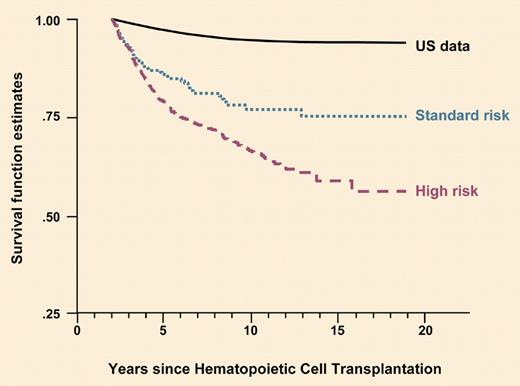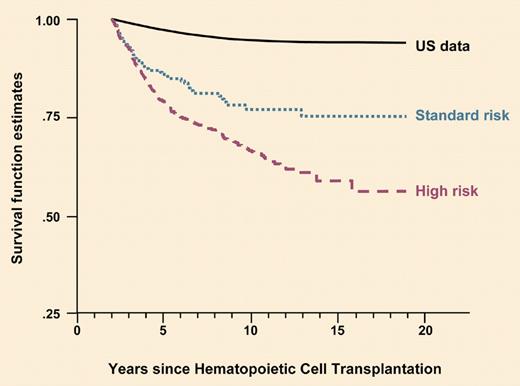Comment on Bhatia et al, page 4215
If patients survive at least 2 years after autologous transplantation for a hematologic malignancy, what can we tell them lies ahead? Bhatia and colleagues help answer this question.
Despite the fact that more than half of stem cell transplantation procedures use autologous stem cells,1 the bulk of the available survivorship literature focuses on allogeneic recipients. By studying a large cohort (N=854) with lengthy follow-up (median, 7.6 years), Bhatia and colleagues help fill an important knowledge gap by providing information about the long-term health of people undergoing autologous stem cell transplantation for hematologic malignancies.
The basic message is that cancer (relapse of the primary disease and secondary malignancies) remains the greatest risk to autologous survivors even if they survive the first 2 years after transplantation. The subsequent risk of mortality is quite high: almost 20% will have died in the next 3 years, primarily of relapse, while an additional 10% die during the period of 5 to 10 years from transplantation. Although the risk of death approaches that of the general population after 10 years for people transplanted with standard-risk disease and acute myeloid leukemia (AML), a persistently elevated risk of death continues for people who underwent transplantation for other diseases or those who entered transplantation with a higher than standard risk of relapse. Thus, major improvements in late medical outcomes will rely on advances that decrease relapse rates and prevent development of secondary malignancies.
All cause mortality in a cohort of 2-year survivors after autologous HCT for hematologic malignancies for the entire cohort by risk of relapse at HCT. See the complete figure in the article beginning on page 4215.
All cause mortality in a cohort of 2-year survivors after autologous HCT for hematologic malignancies for the entire cohort by risk of relapse at HCT. See the complete figure in the article beginning on page 4215.
Unfortunately, there are few clues to be gleaned from the available data in this observational study. In a multivariate analysis, better survival was associated with ages less than 45 years, standard-risk disease, a diagnosis of AML, and inclusion of either total body irradiation or etoposide in the conditioning regimen. Except for the choice of conditioning regimen, the other identified protective factors are not modifiable. One finding of concern is that use of peripheral blood was associated with a 2.4-fold increased risk of nonrelapse mortality, primarily due to secondary myelodysplasia and AML. This observation should be further explored given our current reliance on this autologous graft source.
Preventing secondary malignancies is also problematic since it is not clear if an underlying predisposition to malignancy, pretransplantation therapy, or the transplantation procedure itself is to blame. For the most part, the spectrum of secondary malignancies is not one for which screening is available or effective. Late cardiopulmonary toxicity and other treatment-related sequelae accounted for the remainder of deaths, but prevention of these complications faces the same obstacles as with secondary malignancies.
Bhatia and colleagues also report that autologous survivors experienced greater difficulty in holding jobs due to health reasons and obtaining health and life insurance than sibling controls. Overcoming challenges such as these relies first on identifying the areas of need and particular groups at risk, then designing effective intervention or mitigation strategies. However, addressing job retention and insurance coverage for cancer survivors likely lies more in the realm of vocational training and social policy than medicine.
Thus, while some aspects of this report are very encouraging, there is clearly room to improve on the long-term success of autologous transplantation. The report by Bhatia and colleagues confirms that it can take up to 10 years to get out of the woods, and for some autologous survivors, even 10 years may not be long enough. ▪



